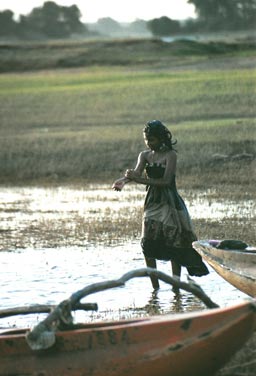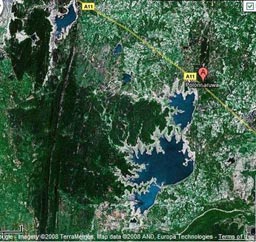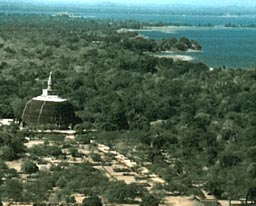Location
Our area of work is located near the town of Polonnaruwa in the North Central Province of Sri Lanka. It is in the north-eastern lowland plains at about 51 m elevation. Its road distance from the capital city of Colombo is about 220 km. For information on how to travel there see Getting There and the interactive map below.
Here we use mainly two places (1) the Smithsonian Primate Research Station that serves as a headquarters and logistic support facility; and (2) the Polonnaruwa Nature Sanctuary, where most of the field work is done.
The Research Station is locally known as the “monkey camp” and is situated in a private patch of natural forest on the eastern shore of the Lake Parakrama Samudra. Coming from Polonnaruwa town (and the Nature Sanctuary), the camp is reached by going south along the “Bund Road” (or Pothgul Mawatha) towards the New Town sub-section of Polonnaruwa. The Pothgul Vihariya and three hotels (Sudu Araliya, Village, and Amalian Nivas) are passed along the way. The main bus and railways stations are in the neighboring town of Kaduruwela. From there the monkey camp is reached by going west along the New Town road.
The site for our studies on primate and ecology is within the Polonnaruwa Nature Sanctuary that doubles as an Archeological Reserve and is also know as the “Sacred City” of Polonnaruwa. The main entrance gate to the sanctuary lies about 3km north of the monkey camp.
Geography
The Polonnaruwa Sanctuary study site is a peninsula of natural forest bordered by a lake, irrigation channel (river), abandoned or only partly used agricultural land and scattered village settlements. It is connected to the more extensive forests of the Angamedilla National Park by a narrow corridor. The terrain is generally flat with a relief of about 50 meters. Nearby hills rise to about 300 meters and the central Sri Lankan massif can be seen in the distance across the lake (Parakrama Samudra). The lake was built in the ninth century by Singhalese kings for agricultural irrigation. Restored after 1920 following eight centuries of disuse, it required no significant structural modifications for modern-day use.
Climate & Weather
Temperatures at Polonnaruwa are best described as comfortably warm to bearably hot, and range between a mean minimum of 77°F/25°C and a mean maximum of 84°F/32°C. The morning hours are the coolest and most pleasant for fieldwork. The noon rest hours can be hot, but a dip in the lake is always refreshing. Late evenings and nights are almost always pleasant; only a sheet or light blanket is required for sleeping. November through February are the coldest months, whereas April and September are the hottest. The heaviest rains fall in November and December. The driest months are June and July, and some slight to moderate rains can be expected in all other months. Strong almost constant dry winds cool the area from May through September. High humidity can be expected after heavy rains.
Culture & Archaeology
Polonnaruwa was the capital of Sri Lanka in the ninth century, but was subsequently abandoned in the 12th century and reverted to jungle. Many spectacular ruins enrich the natural setting and Polonnaruwa is a major archaeological tourist attraction in South Asia.
Sri Lankans are an easy-going, hospitable and friendly people. They pride themselves in the highest literacy rate in Asia (second only to Japan). Creating an interesting and typically tolerant blend in Sri Lankan society is the presence of four major ethnic groups: Singhalese Buddhist (the most populous), Hindu Tamils (the largest minority), Moslems and Christians. Singhalese is the most commonly spoken language in Sri Lanka, especially in rural areas like Polonnaruwa. English is spoken in all tourist hotels, shops and travel-related services.
Sri Lanka is a conservative but very friendly society and good manners and modest dress are appreciated; short shorts and other revealing clothes are inappropriate. Public showing of affection between the sexes (e.g. kissing and touching) is socially unacceptable. Sri Lanka practices free speech and politics and other topics can be discussed openly.
 Research Station & Study Area
Research Station & Study Area
- Our Research Station (monkey or field camp) is located in a private patch of forest on the shores of Lake Parakrama Samudra, and we offer visitor accomodations. more
- We are neighbours to a friendly community of fisher folk who help stock our kitchen with fresh lake fish (mostly Tilapia).
- There are also government offices, schools, banks, small stores, doctors’ offices, bus halt, taxi stand, hotels, and a post office within walking distance from the field camp.
- Most of our research is done at the Polonnaruwa Nature Sanctuary and Archeological Reserve that is located about 4 km north of the field camp. It’s about 10 min by vehicle from the field camp to the sanctuary.
- The sanctuary and forests area around the field camp have an abundance of monkeys, birds and other wildlife. Elephants may visit occasionally.
Flora & Fauna
The dry evergreen forest of Sri Lanka is best envisioned as an intermediate environment, between wet tropical rainforest and dry tropical deciduous forest. It is multi-storied, with a dense shrub layer, a continuous non-deciduous forest canopy between 8-15 meters, and a partially deciduous emergent layer up to 30 meters in height. About 65 different shrub and tree species contribute to the forest’s diversity. At the study site, the shrub layer has been cleared in areas immediately surrounding archaeological ruins. The degree of disturbance to the forest varies within the site. The site serves as a safe haven for over 150 species of birds, 30 species of mammals and a variety of large and small reptiles and amphibians. Elephants, leopard and bear, however, are found only in the more extensive jungle areas in nearby National Parks. Elephants may occasionally visit the site for brief forays.more
Potential Hazards
| Hazard Type | Associated Risk & Precautions |
| Transportation | Major road conditions in Sri Lanka are fair, while rural roads may not be well maintained. The road to Polonnaruwa is newly paved. Road hazards include narrow lanes, fast and reckless drivers, pedestrians and slow moving conveyances including carts, bicycles, etc. Traffic moves on the left side of the road. Experienced and responsible drivers are hired to transport volunteer teams; visitors will NOT be permitted to drive. |
| Terrain | Participants will be walking on footpaths as well as on the forest floor where there are sticks, some rocks and uneven terrain underfoot. There are thorny bushes that can scratch if appropriate clothing and footwear are not worn. |
| Snakes | Sri Lanka has a number of snakes, some venomous, but these are rarely encountered and no observer has been bitten in 40 years of research. |
| Insects | There are surprisingly few biting insects at the project site. Ticks can be troublesome but are easily managed with repellent, and they are not vectors for human disease. A mosquito net and screened housing offers nighttime protection from mosquitoes. |
| Tropical Sun | The tropical sun is stronger than at higher latitudes and sunbathing is not recommended. Participants should wear protective clothing and sunscreen, and should drink plenty of water throughout the day to avoid overheating and dehydration. |
| Sexual Harassment | Young women are advised NOT to travel unaccompanied while not working with the project. |
Health Concerns
Disease mosquitoes may transmit malaria, dengue fever, and Japanese encephalitis. Although these diseases are problems in some areas of Sri Lanka, they are highly unlikely at Polonnaruwa. Be aware that some anti-malarial medication causes undesirable side effects. The malaria in Sri Lanka (falciparum) is not resistant to chloroquine and this drug therefore can be used to treat malaria. Dengue is more common in the south-west wet zone of Sri Lanka. There is no vaccine or preventative medication available for dengue, but basic precautions including insect repellent and protective clothing. Japanese encephalitis is transmitted via mosquitoes so protection from mosquitoes will further lower the risk. Other diseases found in Sri Lanka include filariasis, leptospirosis, hepatitis, typhoid fever, cholera, rabies and HIV/AIDS.
Most diseases are preventable with basic safety cautions. Please see the CDC (www.cdc.gov) or WHO (www.who.int) websites for more information. Food and water Most food on the expedition is cooked and the tap water is safe to drink. Monkeys do not bite observers who use their common sense in relating to wildlife.
Hospitals
A large government hospital and a private one are available within 3 km, or 10 minutes by vehicle. Smaller medical clinics and physicians are also easily accessible.
Transport
A train and bus station area located in the commercial section of town (Kaduruwela) about 15 minutes from the field camp. Local buses and auto rickshaws are the most common mode of local transport. Sedans, jeeps and vans can he hired with their drivers. The nearest airport is north of Colombo, in the town of Katuanayake, and is 5 to 6 hours journey by vehicle from Polonnaruwa.
Hotels
There are three small hotels (3 and 4 star) at Polonnaruwa: the Seruwa, The Village, and Sudu Araliya. All of them are within walking distance of the field camp. The Sudu Araliya Hotel has a large swimming pool and Ayurvedic massage facilities. All three hotels have bars. Numerous smaller hotels are described in popular Tour Guide books (e.g. Lonely Planet).
Entertainment
Polonnaruwa has local standard (non-A/C) movie theaters, screening local and Indian (Bollywood) productions. These are some of the most popular films of the region and offer an interesting cultural experience.


